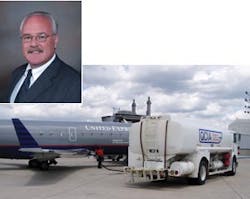As airports across the U.S. look for ways to increase revenues and air service, one consideration for some is the prospect of getting into refueling and ground handling services. Combined, an airport can have an extra tool in its air service development toolbox — as well as a level of service. Quad City International Airport in Moline, IL is already there, via its QCIA Airport Services, which first took over the airline refueling business in 2003, and today offers above and below wing services to charters. On May 10, QCIA Airport Services will begin providing turnkey services for AirTran, in what director Bruce Carter, A.A.E. terms a creative way to ensure the airline’s presence while also exploring a new opportunity.
“AirTran is what makes our great airport exceptional,” is how Quad City’s CFO Holly Green characterized it to an airport finance audience in Seattle recently. She says AirTran brings some 100,000 passengers annually to the Quad Cities, accounting for some $600,000 in yearly landing fees, which she points out helps keep costs lower to other carriers.
Last fall, in the midst of $150/bbl oil and a tanking economy, AirTran came to the airport with “a cry for help,” says Green. The airport responded with an “incentive and support package” It is a two-year commitment intended to save AirTran some $1 million the first year. It will also undergo a four-month trial period, says Green — “to make sure we know how to run an airline as much as an airport.”
Comments Carter, who also serves as chair of the Aviation Ground Services Association (AGSA), an affiliate of the American Association of Airport Executives, “We were looking for creative ways, without getting into direct subsidies or revenue guarantees, and thought that with all the ground handling we’re doing for the charters, and with us being in the airline fueling business for five years, and having the staff in place, we put a proposal to AirTran.
“We said, how about if we started doing above and below the wing? Would you be interested in that?
“We would be open to looking into doing ground handling for other carriers, but we want to make sure at least for the first four months that we get on track.”
The agreement called for the airport to offer a position to each AirTran employee, two-thirds of which stayed on, according to Carter. Additional employees were added and will go to class in Atlanta for an AirTran two-week training course. The airport also purchased all AirTran equipment.
“It’s an investment in AirTran,” says Green. “We are subsidizing this operation.”
Carter relates that his airport has begun to serve as a model for others across the country who are looking at the airline service business. The recent annual meeting of the AGSA in Phoenix showed a heightened interest, he says. “There’s more active interest by some of the smaller communities that might end up having two or three flights from different carriers. They can try and see if they can get to an economy of scale — share the equipment; share the manpower. We saw a lot of different, smaller communities at the conference.
“I get calls once or twice a month – what’s it take? How do you go about getting the equipment? What kind of training?
“We’ll be taking baby steps as we get into this. We’re going to be like other stations that AirTran has with third-party vendors; our LLC is another vendor and we’ll have to shine better.”
Regarding criticism about airports getting into the services business from the private sector, led by the National Air Transportation Association, Carter says, “NATA struggles with this; we’re just trying to make this work to where the airlines are successful in these communities and stay in the marketplace.”





